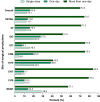Point prevalence survey of antibiotic use among hospitalized patients across 41 hospitals in Thailand
- PMID: 36628340
- PMCID: PMC9825250
- DOI: 10.1093/jacamr/dlac140
Point prevalence survey of antibiotic use among hospitalized patients across 41 hospitals in Thailand
Abstract
Objectives: To describe the antibiotic use among hospitalized patients in Thailand.
Methods: A standardized cross-sectional point prevalence survey (PPS) modified from the WHO PPS protocol was conducted in 41 selected hospitals in Thailand. All inpatients who received an antibiotic at 9 a.m. on the survey date were enrolled. The total number of inpatients on that day was the denominator.
Results: Between March and May 2021, a total of 8958 inpatients were enumerated; 4745 inpatients received antibiotics on the day of the survey and there were 6619 prescriptions of antibiotics. The prevalence of antibiotic use was 53.0% (95% CI 51.1%-54.0%), ranging from 14.3% to 73.4%. The antibiotic use was highest among adults aged >65 years (57.1%; 95% CI 55.3%-58.9%). From 6619 antibiotics prescribed, 68.6% were used to treat infection, 26.7% for prophylaxis and 4.7% for other or unknown indications. Overall, the top three commonly used antibiotics were third-generation cephalosporins (1993; 30.1%), followed by first-generation cephalosporins (737; 11.1%) and carbapenems (703; 10.6%). The most frequently used antibiotics for community-acquired infections were third-generation cephalosporins (36.8%), followed by β-lactam/β-lactamase inhibitors (11.8%) and carbapenems (11.3%) whereas for the patients with hospital-acquired infections, the most common antibiotics used were carbapenems (32.7%), followed by β-lactam/β-lactamase inhibitors (15.7%), third-generation cephalosporins (11.7%) and colistin (11.7%). The first-generation cephalosporins were the most commonly used antibiotics (37.7%) for surgical prophylaxis. Seventy percent of the patients received surgical prophylaxis for more than 1 day post surgery.
Conclusions: The prevalence of antibiotic use among hospitalized patients in Thailand is high and one-quarter of these antibiotics were used for prophylaxis. The majority of surgical prophylaxis was inappropriately used for a long duration post operation. Therefore, it is recommended that local guidelines should be developed and implemented.
© The Author(s) 2023. Published by Oxford University Press on behalf of British Society for Antimicrobial Chemotherapy.
Figures






References
-
- WHO . Antimicrobial Resistance.2021. https://www.who.int/news-room/fact-sheets/detail/antimicrobial-resistance.
-
- Phumart P, Phodha P, Thamlikitkul Vet al. . Health and economic impacts of antimicrobial resistant infections in Thailand: a preliminary study. J Health Sys Res 2012; 6: 352–60.
-
- WHO . Antimicrobial Stewardship Programmes in Health-Care Facilities in Low- and Middle-Income Countries: a Practical Toolkit.2019. https://apps.who.int/iris/handle/10665/329404.
LinkOut - more resources
Full Text Sources
